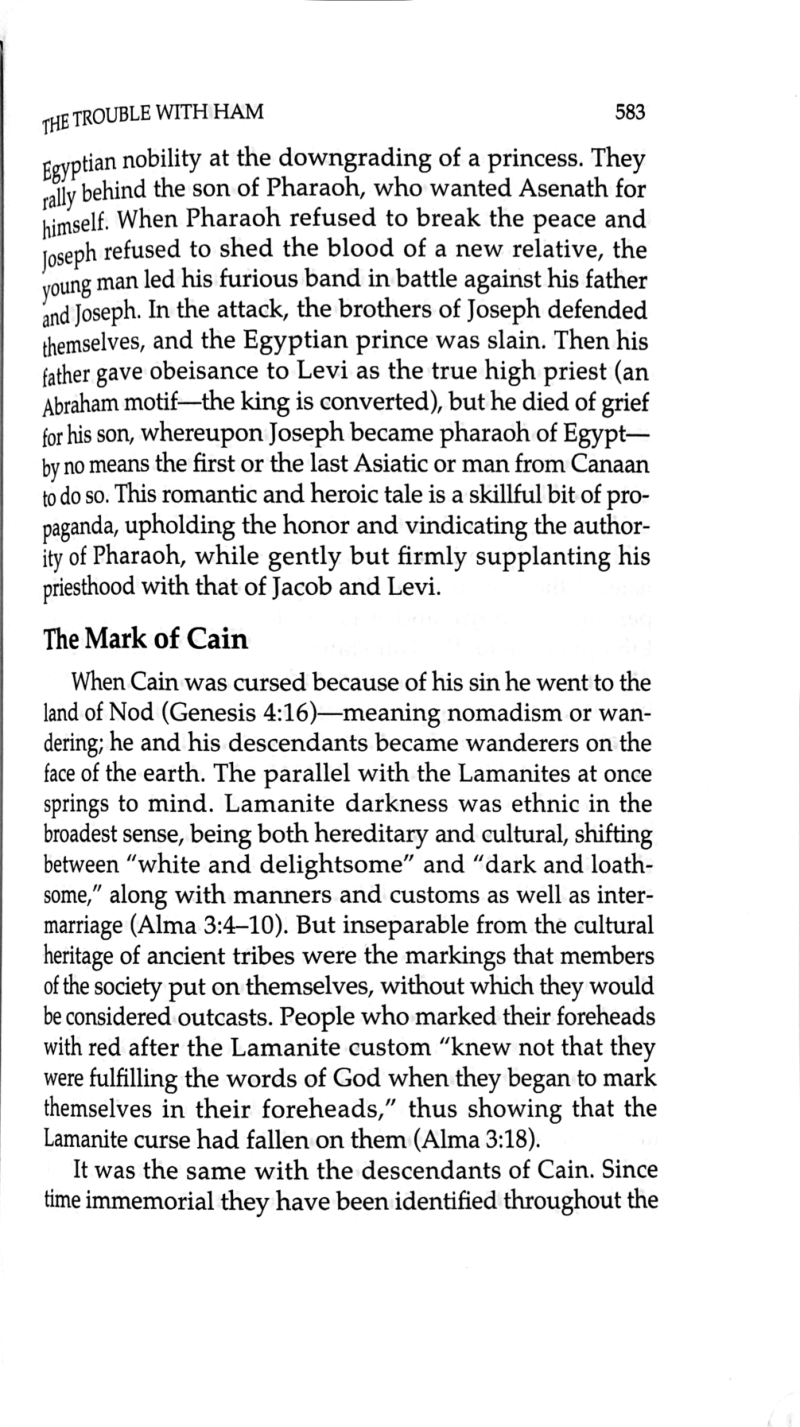Nibley links the "blackness" of Cain with the soot and gime of metalworking.
- Type
- Book
- Hearsay
- DirectSecondary
- Reference
Hugh Nibley, Abraham in Egypt, The Collected Works of Hugh Nibley: Volume 14 (Salt Lake City, UT: Deseret Book; Provo, UT: FARMS, 2000), 583–585
- Scribe/Publisher
- Foundation for Ancient Research and Mormon Studies, Deseret Book
- Audience
- Reading Public
- Transcription
“When Cain was cursed because of his sin he went to the land of Nod (Genesis 4:16)—meaning nomadism or wandering; he and his descendants became wanderers on the face of the earth. The parallel with the Lamanites at once springs to mind. Lamanite darkness was ethnic in the broadest sense, being both hereditary and cultural, shifting between “white and delightsome” and “dark and loathsome,” along with manners and customs as well as intermarriage (Alma 3:4–10). But inseparable from the cultural heritage of ancient tribes were the markings that members of the society put on themselves, without which they would be considered outcasts. People who marked their foreheads with red after the Lamanite custom “knew not that they were fulfilling the words of God when they began to mark themselves in their foreheads,” thus showing that the Lamanite curse had fallen on them (Alma 3:18).
It was the same with the descendants of Cain. Since time immemorial they have been identified throughout the East with those wandering tribes of metalworkers whose father was Tubal Cain. “Thubal bore” “the sins of Cain,” says a midrash, “and followed Cain’s trade. For he prepared weapons for murderers,” a tradition clearly echoed in the Book of Mormon (Ether 8:15). Tubal is the Sumerian tibera, coppersmith or metalworker. As the sign of their mystery and their tribe, the wandering smiths or tinkers have always blackened their faces with soot, a practice still found among journeying sweeps and some others who work at the grimy forge. The name by which they were known was Qenites (cf. Aramaic qnā = smith). The ancient people of Tubal were also connected with Nukhashshe, a name that designated those parts of Asia Minor and Syria where mining and metallurgy are believed to have originated; the same word is the common Semitic root for copper and its alloys, and it is the Egyptian name for the Ethiopians, usually translated as “the Blacks,” nḥsy. According to their own report and universal folklore, these traveling menders of pots and pans must keep traveling because they are under a curse. “They are the Gypsies,” says a very old Judeo-Christian writing, “who carry loads, and they march on the roads with their backs and necks[…]” “a Tau-sign or a circle and cross. In Genesis it is the brand of Cain, ancestor of the Kenites, and in Ezekiel it is the divine mark set on the brows of all just men. According to a midrash, God placed a letter of the alphabet on Cain’s hand as a mark, so that no one would slay him, and some of the Jewish doctors maintained that “the ‘Sign of Cain’ was the mark on David’s brow.” Certain it is that “the mark of Cain” goes along with a cursing, a wandering way of life, and a distinctive mark on the body.”
- Citations in Mormonr Qnas
The B. H. Roberts Foundation is not owned by, operated by, or affiliated with the Church of Jesus Christ of Latter-day Saints.

